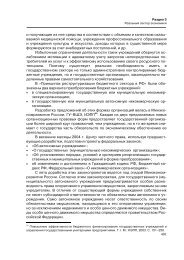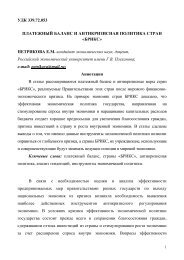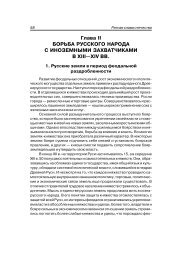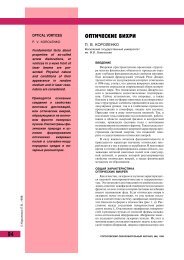Ensuring Strategic Stability in the Past and Present:
Ensuring Strategic Stability in the Past and Present:
Ensuring Strategic Stability in the Past and Present:
You also want an ePaper? Increase the reach of your titles
YUMPU automatically turns print PDFs into web optimized ePapers that Google loves.
Chapter 5: The Goal of Prevent<strong>in</strong>g Escalatory Dom<strong>in</strong>ationThe problem of secur<strong>in</strong>g strategic stability should be considered not just <strong>in</strong> <strong>the</strong> context of nuclearwarprevention, but also <strong>in</strong> <strong>the</strong> context of <strong>the</strong> <strong>in</strong>admissibility of escalation-driven dom<strong>in</strong>ation byone side <strong>in</strong> a severe political <strong>and</strong> military crisis, especially if <strong>the</strong> latter may develop <strong>in</strong>to a nuclearconflict.It should be borne <strong>in</strong> m<strong>in</strong>d that <strong>the</strong> United States, on a much larger scale than Russia, has devoteddecades to develop<strong>in</strong>g a body of <strong>the</strong>ory on <strong>the</strong> applied aspects of crisis- <strong>and</strong> conflict-escalationwith explicit military components.One of <strong>the</strong> milestones <strong>in</strong> consideration of <strong>the</strong>se problems was <strong>the</strong> 1965 publication of HermanKahn’s foundational “On Escalation.” Kahn worked at <strong>the</strong> R<strong>and</strong> Corporation <strong>and</strong> later founded<strong>the</strong> Hudson Institute. “On Escalation” represented <strong>the</strong> f<strong>in</strong>d<strong>in</strong>gs of a series of studies he carriedout for <strong>the</strong> U.S. Department of Defense. In this work, experts were primarily <strong>in</strong>trigued by Kahn’s<strong>in</strong>troduction of <strong>the</strong> concept of <strong>the</strong> “escalation ladder” <strong>in</strong> crisis situations. The escalation ladderconsisted of 44 “steps” <strong>and</strong> six “thresholds.” The top threshold that followed <strong>the</strong> 38th step on <strong>the</strong>ladder was <strong>the</strong> city-target<strong>in</strong>g threshold—that is, <strong>the</strong> commencement of <strong>the</strong> launch<strong>in</strong>g of nuclearstrikes on <strong>the</strong> adversary’s cities. 53 These R&D activities formed <strong>the</strong> basis for <strong>the</strong> development severaldecades ago of a system designed to gradually improve <strong>the</strong> combat read<strong>in</strong>ess of U.S. militaryforces. In <strong>the</strong> political <strong>and</strong> <strong>the</strong> military st<strong>and</strong>-offs that occur dur<strong>in</strong>g <strong>in</strong>ternational political crisissituations, top U.S. leaders can send valuable signals to <strong>the</strong>ir opponents—as well to its allies <strong>and</strong><strong>the</strong> <strong>in</strong>ternational community as a whole—regard<strong>in</strong>g American <strong>in</strong>tentions by manipulat<strong>in</strong>g <strong>the</strong>degree of U.S. forces’ combat read<strong>in</strong>ess.It is entirely possible that <strong>in</strong> a certa<strong>in</strong> crisis situation, we may see Wash<strong>in</strong>gton try<strong>in</strong>g to use <strong>the</strong>pr<strong>in</strong>ciples <strong>and</strong> methods that provide for escalatory dom<strong>in</strong>ation. (Such a perspective <strong>in</strong> <strong>the</strong> contextof U.S.-S<strong>in</strong>o relations has been seriously considered by Ch<strong>in</strong>ese <strong>the</strong>oreticians <strong>and</strong> practicalexperts over <strong>the</strong> past 10 to 15 years; this is primarily related to a potential crisis over Taiwan <strong>in</strong>which Ch<strong>in</strong>a, <strong>in</strong> order to exercise all its sovereign rights, decides to use military force. Ch<strong>in</strong>eseplans regard<strong>in</strong>g <strong>the</strong> development of that nation’s strategic nuclear forces are largely aimed at <strong>the</strong>prevention of escalatory dom<strong>in</strong>ation aga<strong>in</strong>st Ch<strong>in</strong>a. These plans extend as high as <strong>the</strong> developmentof a number of tactical <strong>and</strong> technical characteristics of nuclear missiles, <strong>in</strong>clud<strong>in</strong>g l<strong>and</strong>basedmobile missile systems like DongFeng 31 <strong>and</strong> DongFeng 31A. Escalatory dom<strong>in</strong>ation mayprimarily rest upon <strong>the</strong> advantages which <strong>the</strong> United States has tried to lock <strong>in</strong> for itself <strong>in</strong> <strong>the</strong>areas of strategic nuclear weapons <strong>and</strong> conventional weapons s<strong>in</strong>ce <strong>the</strong> end of <strong>the</strong> Cold War <strong>and</strong><strong>the</strong> dissolution of <strong>the</strong> Soviet Union. Attempts to exert such dom<strong>in</strong>ation may be extremely dangerous<strong>in</strong> a conflict or crisis situation.The best way for Russia to block attempts at escalatory dom<strong>in</strong>ation is by ensur<strong>in</strong>g <strong>the</strong> availabilityof thoroughly developed mechanisms for resolv<strong>in</strong>g conflicts <strong>and</strong> crisis situations, based on<strong>the</strong> national Russian system of crisis management <strong>and</strong> <strong>the</strong> adequate military power of Russia. Itappears that <strong>the</strong> importance of <strong>the</strong> availability of a system of crisis management is belittled byRussian scientists <strong>and</strong> representatives of <strong>the</strong> state apparatus <strong>and</strong> <strong>the</strong> political class as a whole. Thistopic is barely covered by Russia’s conflict-study discipl<strong>in</strong>es as a politological sub-discipl<strong>in</strong>e, due30<strong>Ensur<strong>in</strong>g</strong> <strong>Strategic</strong> <strong>Stability</strong> <strong>in</strong> <strong>the</strong> <strong>Past</strong> <strong>and</strong> <strong>Present</strong>: Theoretical <strong>and</strong> Applied Questions
















